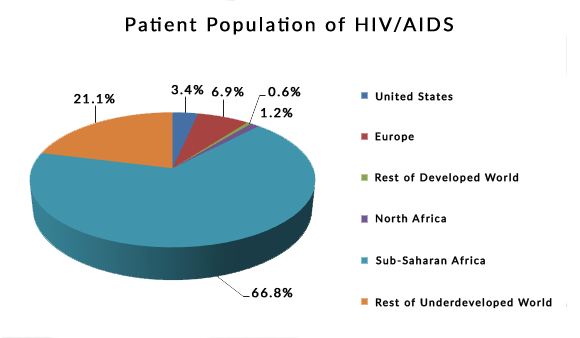HIV/AIDS

HIV infection is a chronic, progressive disease, caused by viral replication within CD4 positive cells that eventually destroys the cells. Initially the immune system is capable of producing new cells to replace those that are destroyed -transplantation. The early stages of HIV infection T-cell levels generally remain near normal. This period of the disease is known as the dormant stage since few symptoms are apparent. Based on clinical data the average time between infection and the development of full-blown AIDS is over 10 years. With time the CD4 count declines as T-cells are destroyed more rapidly than the immune system can produce them, leading to serious impairment of immune function. A dramatic increase in susceptibility to opportunistic infections has been observed with an absolute CD4 count of 200 cells/mm3 or fewer. Overall survival among patients who have an AIDS-defining diagnosis (over 30 conditions have been identified) and fewer than 200 CD4 cells is to the order of 3 years, but with wide variation.

For most patients, the course of AIDS can be characterized as repeated acute episodes of illness with a background of slowly declining health and function. Sudden death is rare. Most patients become bed-bound for weeks to months before death, requiring increasing support including home infusion of antibiotics, nursing care, nutritional supplementation, and in many cases treatment for anxiety and depression.
AIDS has become the most devastating infectious disease humankind has ever faced. Since the epidemic began, more than 60 million people have been infected with the virus. Worldwide, it is the fourth-biggest killer. At the end of 2001, an estimated 40 million people globally were living with HIV.
Worldwide Prevalence of HIV

Recently there has been a rise in the incidence of HIV infection in developed nations. Advances in treatment and care in these countries are not being consistently matched with enough progress on the prevention front. New evidence of rising HIV infection rates in North America, parts of Europe and Australia is emerging. Unsafe sex, reflected in outbreaks of sexually transmitted infections, and widespread injection drug use are propelling these epidemics.
Advances in medication have increased the life span of AIDS patients, but the impact has been modest. Experts believe current treatments only extend life by 1.8 years on average. The following multifactorial etiologies contribute to the eventual decline in therapeutic efficacy:
- HIV is prone to mutations that produce resistance to reverse transcriptase and protease inhibitors. Once resistance emerges to one drug, these strains may also be resistant to most, if not all, of the drugs in the same chemical or functional group
- Patient compliance with existing HIV treatment regimens is a significant issue that mitigates therapeutic success. In an effort to overcome resistance, physicians have begun prescribing reverse transcriptase and protease inhibitors in various combinations. The demands of these complex drug dosing regimens are often too great for long-term patient adherence
- Clinical studies indicate that a significant number of HIV positive patients discontinue therapy soon after they begin treatment because they cannot tolerate the toxic side effects. These include gastrointestinal disorders, peripheral neuropathy, kidney stones, and diabetes-like symptoms
